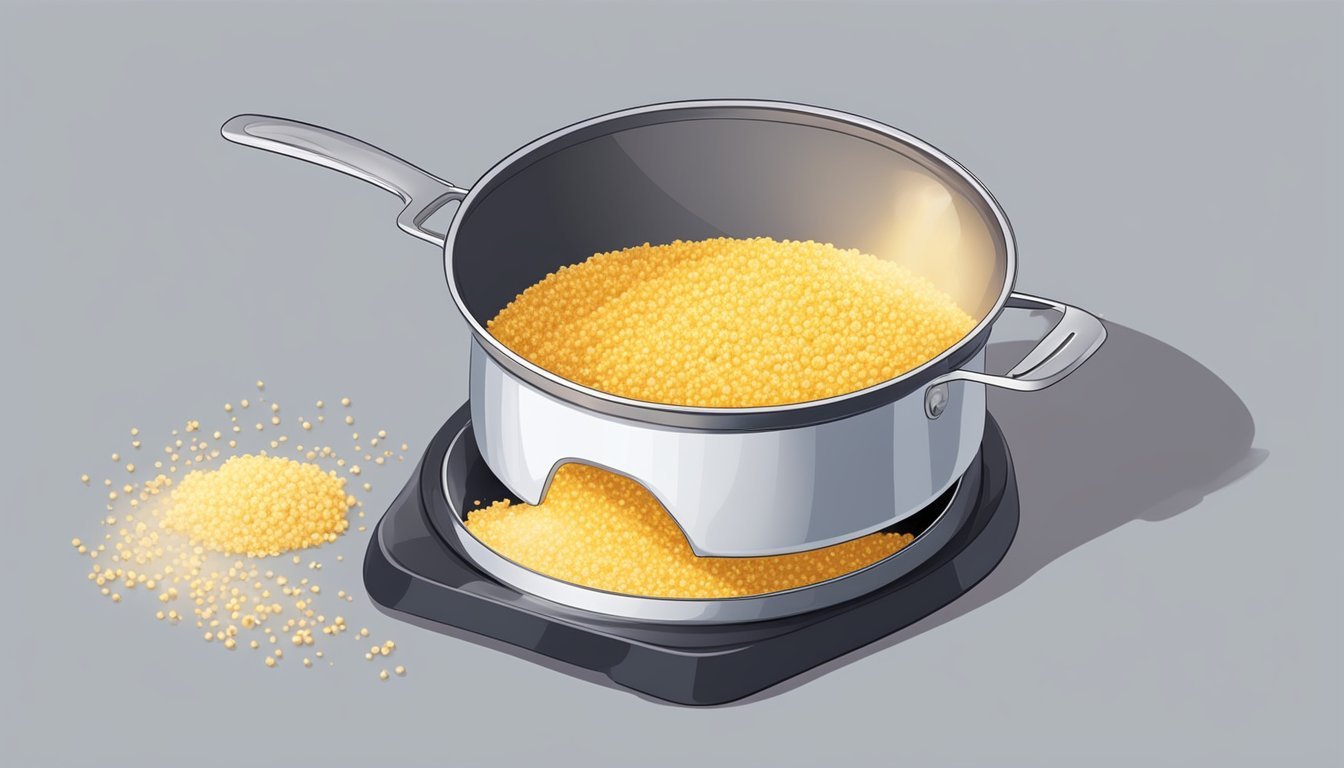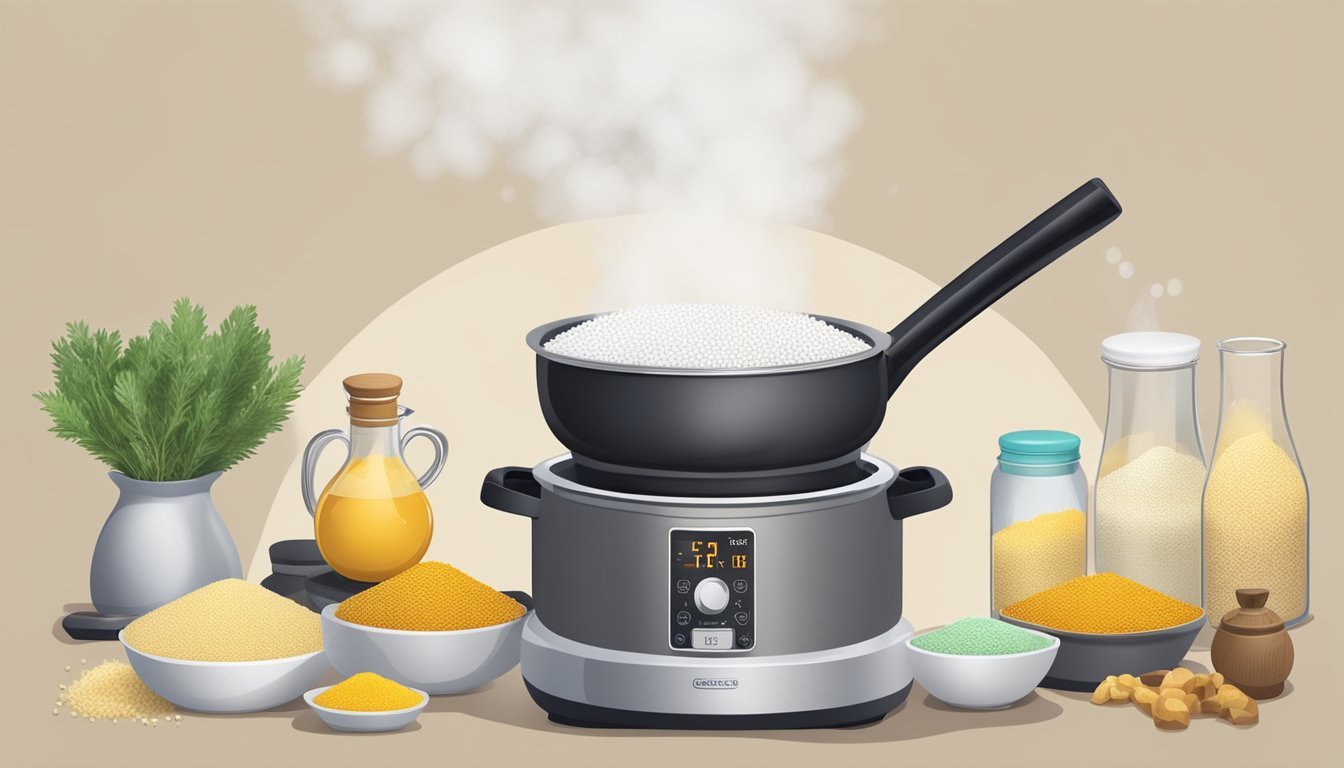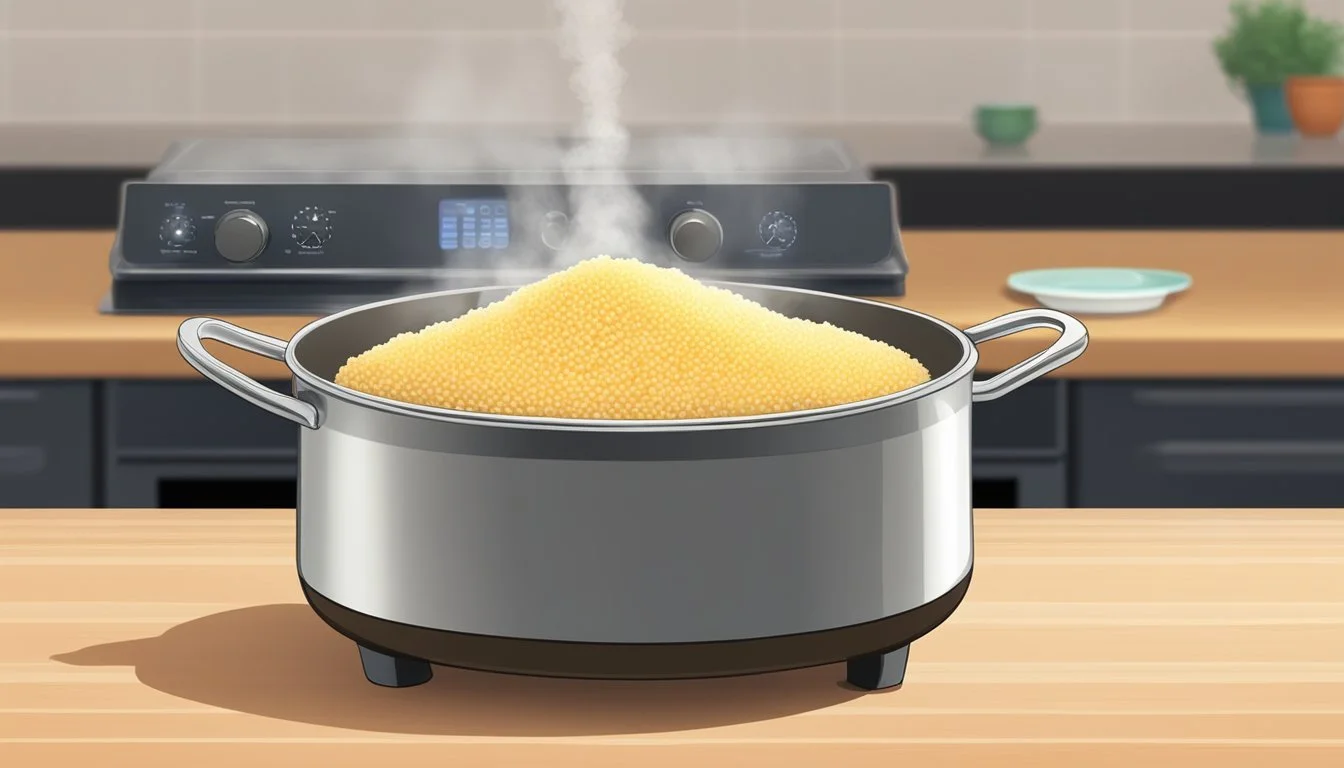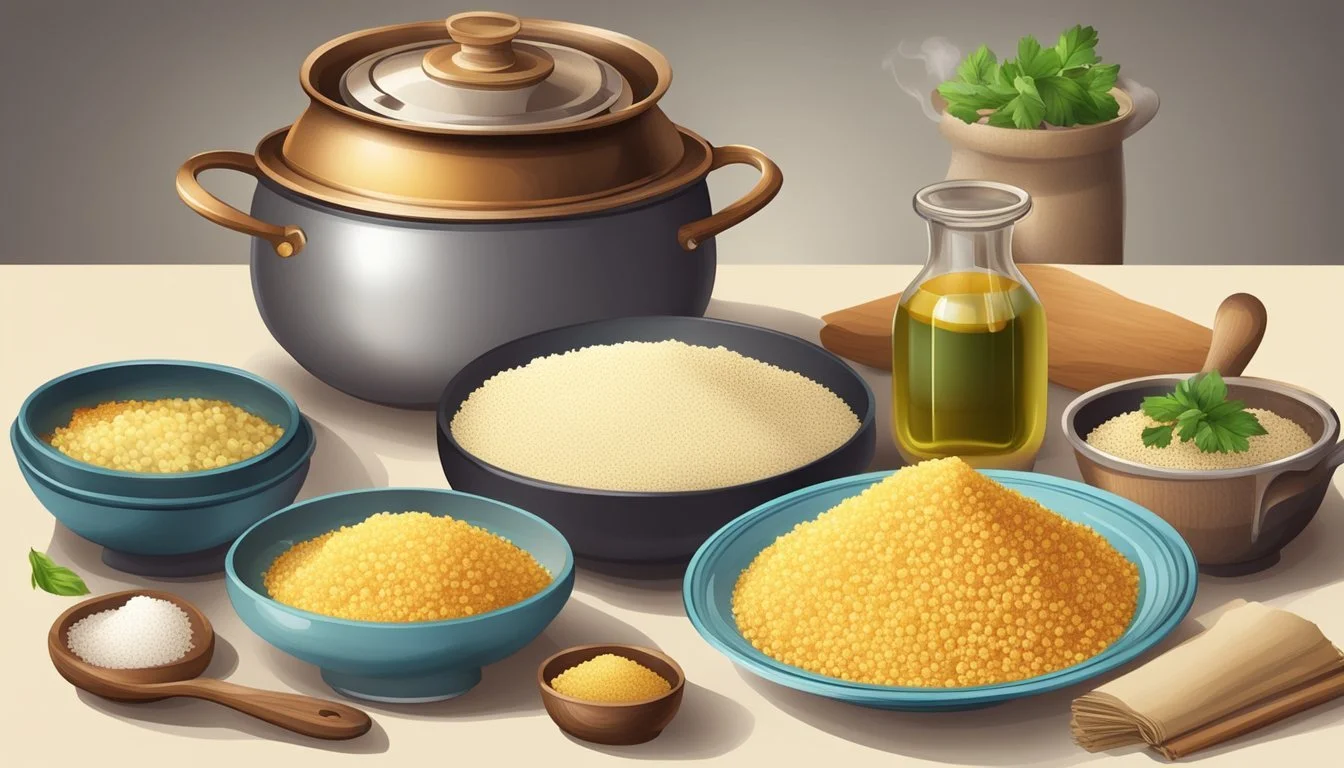How to Cook with Couscous
Master Quick and Fluffy Side Dishes
Couscous (What wine goes well with couscous?) is a versatile staple that can elevate the simplest of meals with its fluffy texture and ability to absorb flavors beautifully. This granular semolina, a traditional North African dish, transcends cultures and is widely embraced for the speed and ease with which it can be prepared. As a side dish, couscous offers an excellent alternative to rice or pasta, pairing well with a range of proteins and vegetables. Due to its quick-cooking nature, it's particularly favored by those seeking to put together a nutritious meal in a short time frame.
The key to perfectly fluffy couscous lies in the ratio of water to couscous, along with the proper steaming technique. Generally, the process involves bringing water or broth to a boil, which is then poured over the couscous and left to absorb and steam, covered, off of the heat source. This method allows the couscous to swell and become tender without becoming mushy or clumpy, a hallmark of impeccably cooked couscous.
Given its simplicity, couscous is a blank canvas for a wide array of seasonings and ingredients, making it an ideal quick side dish for everyday meals as well as special occasions. It can be enlivened with additives like olive oil, lemon juice, and herbs, or toasted for additional depth of flavor. Cooking couscous properly ensures a side dish that is not only quick and easy to prepare but also presents an appealing texture and serves as a backdrop to the flavors of the accompanying meal.
Understanding Couscous
In the realm of grains and grain-like foods, couscous stands out for its ease of preparation and versatility in various cuisines. It is a staple in many cultures and comes in different varieties, each with its own distinctive qualities.
Origins and Types
Couscous is a traditional North African dish made from semolina flour which is derived from durum wheat. It has been a staple food across many North African countries for centuries, with its roots most prominently tied to Moroccan cuisine. There are three main types of couscous:
Moroccan Couscous: The smallest in size and the quickest to cook. It is typically steamed and can become fluffy and light when prepared correctly.
Israeli Couscous (also known as pearl couscous): Larger in size and resembles small beads. It has a chewier texture and takes a bit longer to cook compared to Moroccan couscous.
Lebanese Couscous: The largest of the three, with a size similar to peas, requiring the longest cooking time.
Each type of couscous brings a different texture to the table and can be chosen based on the specific dish being prepared.
Couscous Versus Other Grains
Couscous is often lumped together with whole grains, but it's important to note that couscous is actually a type of pasta, as it is made from semolina flour that is moistened and formed into small granules. Here is a comparison with other grain-like foods:
Quinoa: (What wine goes well with quinoa?) A true grain and a complete protein, quinoa is gluten-free and cooks up with a slightly nutty flavor. Unlike couscous, which is pasta, quinoa is a seed.
Bulgur: Made from whole wheat that is partially cooked and then dried, bulgur has a similar texture to couscous but with a nuttier flavor. It is also considered a whole grain.
Farro: An ancient grain with a chewy texture and a rich, nutty flavor. Farro takes longer to cook than couscous and is richer in fiber.
Couscous is unique in its quick cooking time and delicate texture, making it an excellent choice for those seeking a fast and fluffy side dish that readily absorbs flavors from other ingredients. It can be a lighter alternative to grains like farro or quinoa but doesn't boast the same whole grain benefits.
Preparing the Kitchen
Before cooking, ensuring the kitchen is well-prepared is essential for an efficient and enjoyable couscous cooking experience. One should have all necessary tools and high-quality ingredients on hand.
Required Tools and Ingredients
To make couscous, these tools and ingredients are required:
Tools:
Medium saucepan
Non-stick skillet or pan
Wooden spoon
Fork (for fluffing the couscous)
Ingredients:
Couscous
Liquid for cooking (water, vegetable broth, or chicken broth)
Extra virgin olive oil and/or butter
Salt (kosher or sea salt)
Optional for flavor: lemon zest, chopped parsley
Selecting Quality Couscous
Choosing the right type of couscous can greatly affect the dish's texture and flavor. Look for:
Whole grain couscous: It's more nutritious and has a heartier texture.
Medium-grain couscous: It's the standard kind and best for a fluffy result.
Pre-steamed couscous: This option saves time, as it cooks quickly.
Remember, the key to a great couscous recipe is to start with quality extra virgin olive oil and a pinch of salt, which enhance the couscous's natural flavor.
The Cooking Process
Cooking couscous is a simple task that can yield a wonderfully fluffy and versatile side dish when done correctly. The process involves proper liquid-to-couscous ratios, specific steps to enhance fluffiness, and the addition of flavors for a more enticing dish.
Basic Cooking Instructions
Couscous cooking typically starts with boiling the appropriate amount of cooking liquid, usually water or broth. The standard liquid to couscous ratio is 1:1, meaning one cup of liquid per one cup of couscous. However, instructions may vary slightly depending on the couscous type and desired texture.
Boil the Liquid: Bring the cooking liquid (water or broth) to a rolling boil in a saucepan.
Combine: Pour the couscous into the boiling liquid, ensuring it is evenly spread.
Remove from Heat and Cover: Take the saucepan off the heat and tightly cover it with a lid to allow the couscous to absorb the liquid.
Rest and Absorb: Let it sit, covered, usually for about 5 minutes, so the grains absorb the liquid fully.
Optimizing Fluffiness
For couscous that is especially light and fluffy, a few key points should be kept in mind:
Steaming Time: Allow the couscous to steam adequately after absorbing the liquid; this can take around 5 minutes.
Fluff with a Fork: After steaming, use a fork to gently separate the grains, which introduces air between them and enhances fluffiness.
Flavor Enhancements
Couscous easily takes on the flavor of other ingredients, making it a perfect canvas for a wide array of seasonings. Here are some ways to infuse more taste into the dish:
Toast the Couscous: Before boiling, heat some olive oil in a pan and briefly toast the couscous until golden. This adds a nutty depth to its flavor profile.
Herbs and Spices: Incorporate herbs like parsley or spices like cumin to lend aromatic complexities to the couscous.
Aromatics: Sauté garlic in the saucepan before adding the liquid to impart a savory note to the couscous.
Citrus Zest: Stir in some lemon juice or zest after cooking to add a fresh, citrusy accent.
Butter for Richness: A pat of butter can be melted into the cooked couscous for a touch of richness and a silkier texture.
By paying attention to the ratio of liquid to couscous, ensuring a proper steaming period, and experimenting with flavorful add-ins, one can master the art of cooking couscous that is both quick and satisfying.
Couscous Variations
Couscous, a North African dish popular in countries like Algeria and Morocco, offers versatility for an array of delectable recipes. This section explores the different ways in which couscous can be tailored to fit any occasion or dietary need.
Recipes for Every Occasion
Couscous is highly adaptable, lending itself to a variety of recipes that can range from simple side dishes to more intricate main courses. Here are some popular options:
Salad: Couscous makes for a light yet satisfying salad base. Incorporating fresh vegetables, herbs, and a tangy dressing can transform it into a Mediterranean delight.
Side Dish: For an instant couscous side, simply mix in olive oil, salt, and aromatic spices. Pair it with vegetables or lean proteins for a complete meal.
Main Course: Layer couscous with vegetables, chickpeas, raisins, and nuts, creating a vegetarian centerpiece that's both nutritious and flavorful.
Dietary Considerations
Couscous caters to various dietary preferences and restrictions, ensuring everyone can enjoy its light, fluffy texture:
Vegetarian and Vegan: Couscous serves as an excellent base for plant-based diets. For vegan options, avoid using broths and opt for water or vegetable stock as the cooking liquid.
Gluten-Free: While traditional couscous is made from semolina wheat, gluten-free alternatives are available, usually made from corn or rice flour.
Low-Sodium: For a low-sodium version, skip adding salt during preparation, and rely on the natural flavors of your other ingredients or incorporate salt-free spice blends.
Creative Serving Suggestions
Couscous offers a versatile canvas for a range of flavors and ingredients, transforming a simple side into a standout dish. Here are some suggestions on how to pair and present couscous with distinction.
Pairings and Add-ins
Grain Bowl: Layer couscous at the base of a grain bowl and top it with a variety of colorful vegetables, protein sources like salmon or chicken, and a sprinkle of fresh herbs for a nutritious and satisfying meal.
Fresh Herbs: Incorporate chopped fresh herbs such as cilantro, mint, or dill into couscous to give a burst of fresh flavor to each bite.
Nuts and Dried Fruit: To add texture and sweetness, mix in nuts like toasted pine nuts or almonds, and dried fruit such as raisins or apricots.
Veggies: Stir through sautéed or roasted vegetables for added nutrients and flavors. Couscous pairs well with a variety of veggies, from bell peppers to zucchini.
Presentation Tips
Garnish: Always garnish the couscous dish with additional herbs or a sprinkle of nuts right before serving for a visually appealing and crunchy topping.
Color Contrast: When arranging the bowl or plate, consider the color contrast for visual appeal. A sprinkle of bright green herbs or a few jewel-toned dried cranberries can make the dish pop.
Making Couscous a Healthy Choice
Couscous can serve as a nutritious component of a meal when prepared thoughtfully. It offers versatility in diet planning and can contribute significantly to daily nutritional intake.
Nutritional Information
Couscous is often praised for its protein content and trace nutrients. It can particularly be a source of fiber when whole grain varieties are utilized. Nutritionists often regard it as a healthier grain option that can be included in a plant-based diet. Here's a brief look at its nutritional value per 1 cup of cooked couscous:
Calories: Approximately 176
Protein: 6 grams
Fiber: 2 grams
Fat: 0.25 grams
Carbohydrates: 36 grams
Whole grain couscous contains more fiber and nutrients than its refined counterparts, making it the preferred choice for a healthful diet.
Incorporating Couscous into a Balanced Diet
Couscous integrates well into a balanced diet, serving as a base for a variety of healthful dishes. It's a versatile ingredient that becomes tender when cooked and pairs well with vegetables, lean proteins, and legumes. To enhance the nutritional profile of a couscous dish, one can:
Opt for whole grain couscous to increase fiber intake.
Use it as a substitute for refined grains in recipes.
Combine with a variety of colorful vegetables to add vitamins and minerals.
Include legumes like chickpeas or lentils for added plant-based protein.
By including couscous as part of a varied diet, individuals can enjoy both its health benefits and culinary flexibility.
Troubleshooting Common Issues
When cooking couscous, achieving the perfect texture is essential for a satisfying side dish. This section helps resolve common hurdles encountered during the cooking process.
Avoiding Sogginess
To prevent couscous from becoming soggy, it is crucial to use the correct water-to-couscous ratio. A general guideline is a 1:1 ratio, with adjustments made for desired tenderness. After boiling the water, pour the dry couscous in and remove it from heat. Cover the pot to allow the couscous to absorb the water and become tender. The couscous should be left to steam typically for 5 minutes; any longer could compromise the texture.
Correct Ratio: 1 cup couscous to 1 cup liquid
Cover and Steam: 5 minutes off the heat source
Textural Adjustments
For a fluffier result, once the couscous has absorbed the water, one should use a fork to separate the grains. This action fluffs the couscous and helps prevent clumping. If couscous is too dense or undercooked, a slight addition of water and further steaming can be employed for a fuller yield. In contrast, if the couscous is too moist, spreading it out on a baking sheet to allow excess moisture to evaporate may help.
Fluff with Fork: Prevents grains from sticking
Cooking Adjustments: Add water or steam longer for tenderness; spread to dry for a less moist texture
Storing and Reheating
When it comes to couscous, proper storage can make a significant difference in retaining its quality. For optimal results in both preservation and reheating, couscous should be handled with care to maintain its delicate texture and flavor.
Proper Storage Methods
To ensure couscous maintains its best quality as leftovers, one should refrigerate it within two hours of cooking. Couscous should be stored in an airtight container to prevent it from absorbing unwanted odors and to retain moisture that keeps it from drying out. This method helps to prolong the freshness of the couscous for 3 to 5 days in the refrigerator.
Refrigeration:
Within 2 hours of cooking
Airtight container
Duration: 3-5 days
Reheating Without Drying Out
For a satisfying plate of fluffy couscous, reheating should reintroduce moisture without making it soggy. To achieve this balance:
Microwave Method:
Add a tablespoon of water or stock per cup of leftover couscous.
Cover with a damp paper towel to create steam.
Heat in 30-second intervals, fluffing with a fork in between, until thoroughly warmed.
Stovetop Method:
Heat a skillet over medium heat with a small amount of olive oil or butter.
Stir in the couscous, allowing it to absorb the moisture from the oil or butter.
Cook for 2-3 minutes, continuously stirring, until it is hot throughout.
Remember to always check the couscous for any signs of spoilage before reheating.
Exploring Cultural Significance
Couscous is not just a staple of North African cuisine; its cultural significance spans centuries and continents. Often featured in festive dishes and everyday meals, couscous embodies the culinary traditions and adaptability of the regions it hails from.
Couscous in North African Cuisine
In North African countries, couscous is more than a mere side dish; it is a celebrated food that holds a special place in the hearts of many. Moroccan couscous, for instance, is central to the Moroccan diet and is traditionally served with a tagine, a slow-cooked stew that often includes meats, vegetables, and savory spices. The fluffiness of couscous seamlessly complements the rich and aromatic flavors of the tagine.
Lebanese couscous, or Moghrabieh, is another regional variant, featuring larger, pearl-sized grains that are served with meats like chicken and a fragrant broth. Meanwhile, ptitim, known as Israeli couscous, although not a traditional couscous, has become a popular side dish in Mediterranean and Middle Eastern cuisines, prized for its versatility and pasta-like texture.
Key Components of North African Couscous Dishes:
Couscous: Steamed until light and fluffy
Tagine: A savory stew with vegetables and meats
Spices: Cinnamon, saffron, cumin, and others enhancing the flavor
Global Influence and Adaptations
Couscous has transcended its North African origins to become a beloved ingredient across the globe. A testament to its versatility is the Mediterranean couscous salad, an adaptation that combines couscous with fresh vegetables, tangy dressings, and sometimes cheese, creating a light and vibrant dish.
Chefs and home cooks around the world have embraced couscous for its ease of preparation and its ability to absorb flavors, making it an excellent canvas for culinary creativity. Whether it's paired with lamb in a Moroccan feast or tossed with tomatoes and feta in a Mediterranean salad, couscous continues to adapt to the tastes and ingredients of various cultures while still honoring its North African roots.
Adaptations Around the World:
Mediterranean Couscous Salad: Often includes fresh vegetables, feta, and a light dressing
Fusion Dishes: Combines couscous with non-traditional ingredients for innovative meals
Couscous's global journey from North African kitchens to international tables showcases its cultural impact and enduring appeal as a culinary staple.
Resources and Further Learning
For those who seek to master the art of cooking with couscous and wish to create dishes ranging from a simple couscous salad to a more elaborate herbed couscous recipe with roasted cauliflower, a rich tapestry of resources is available. Below are curated guides and community platforms where enthusiasts can gather knowledge, share experiences, and find necessary cooking instructions and ingredients.
Cookbooks and Guides
"Couscous: Fresh and Flavorful Contemporary Recipes" by Victoria Bedwell: This book provides a comprehensive look at couscous preparation, from the basics to more creative incarnations like the best Mediterranean couscous salad.
"The Complete Mediterranean Cookbook" by America's Test Kitchen: A reliable source for meticulously tested recipes, including various couscous dishes that align with Mediterranean dietary practices.
Online Culinary Communities
Couscous Lovers Forum: A dedicated online space where members share their favorite recipes, tips for achieving fluffy couscous, and feedback on their culinary adventures.
Chef’s Corner: A site where professional chefs conduct webinars on cooking techniques, including perfecting grains like couscous.
Shop Gourmet: An online shop that not only sells high-quality couscous but also offers detailed cooking instructions tailored to their specific products.
Couscous as a Pantry Staple
Couscous is a versatile grain that serves as a convenient and affordable pantry staple. It offers a quick alternative to rice, with a shelf-stable nature that makes it a reliable ingredient for many.
Selecting for Your Pantry
When stocking couscous, one should consider the variety that best suits their cooking style. Types of couscous include:
Traditional: This variety requires steaming and fluffing and has a medium grain size.
Israeli or Pearl: Larger in size and requires boiling, delivering a chewier texture.
Lebanese: The largest grain size that cooks much like pasta and is ideal for heartier dishes.
Each type offers a different texture and cooking time, thus providing flexibility and diversity for multiple culinary applications. Storing couscous in a cool, dry place can preserve its shelf life up to 12 months, ensuring that it remains a shelf-stable resource in the kitchen.
Accessibility and Affordability
Couscous is not only affordable and convenient but is also widely available in supermarkets. Here are its benefits outlined:
Cost-effective: Couscous is typically less expensive than other grains and offers substantial servings per package.
Widely accessible: Found in most grocery stores, it is an accessible option for individuals seeking a nutritious and easy-to-prepare side dish.
Quick preparation: Cooking times are generally short, with most varieties ready in under 15 minutes, making it a practical choice for time-sensitive meals.
As it stands, couscous's place in the pantry is justified by its ease of use, cost efficiency, and adaptability, marking it as a staple for both spontaneous meal prep and planned dining alike.





